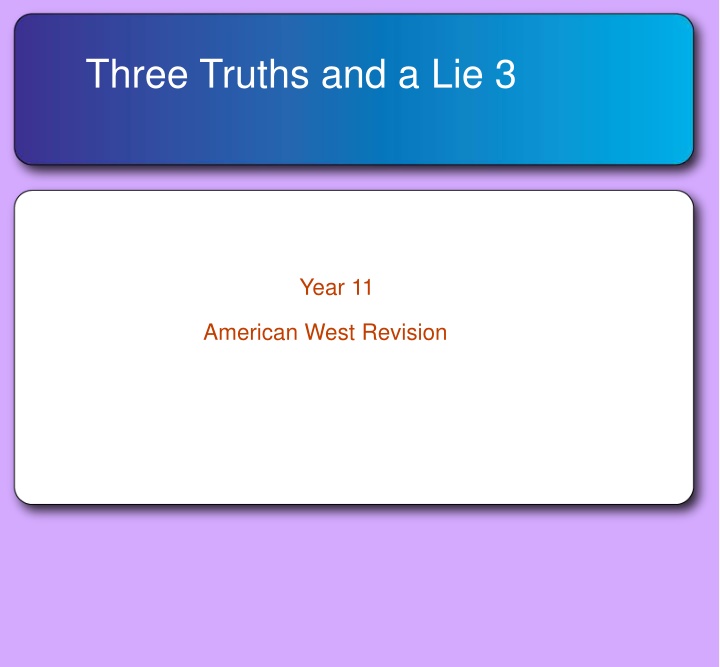
American West Homesteading: Truths and Challenges
Explore the trials and tribulations faced by homesteaders in the American West during the 19th century. Uncover the truths and lies behind the struggles of adapting to life on the Plains, from crop devastation to disease outbreaks. Discover the reasons driving pioneers to move westward and the resilience required to make a homestead successful.
Download Presentation

Please find below an Image/Link to download the presentation.
The content on the website is provided AS IS for your information and personal use only. It may not be sold, licensed, or shared on other websites without obtaining consent from the author. If you encounter any issues during the download, it is possible that the publisher has removed the file from their server.
You are allowed to download the files provided on this website for personal or commercial use, subject to the condition that they are used lawfully. All files are the property of their respective owners.
The content on the website is provided AS IS for your information and personal use only. It may not be sold, licensed, or shared on other websites without obtaining consent from the author.
E N D
Presentation Transcript
Three Truths and a Lie 3 Year 11 American West Revision
1 Problems faced by homesteaders: A Some parts of the Plains were more fertile than others so it was easier to grow things there B Due to drought, 11,000 homesteads were repossessed in Kansas between 1889 and 1893 C Homesteaders who found it difficult to adapt found it most difficult to survive D There were regular plagues of flying ants which decimated crops in the 1870s. Sometimes the columns of them covered nearly 40,000 square kilometres.
2 More problems faced by homesteaders: A Sodhouses were very leaky when it rained and infested with mice and insects B Illness, particularly the Black Death, was very common among homesteaders; rats in the New Mexican desert still carry the plague germ. C There was very little wood for building houses or to burn as fuel. D Most sodhouses had real glass windows fitted into their walls.
3 Making a success of a homestead: A New machinery like threshers and reapers were useless on the Plains because they didn t have the wood to fuel them, so they just worked harder B Homesteader women used to keep chickens and plant fruits and vegetables to supplement the crops that were grown C Homesteader women used to treat snakebites by applying warm manure to the bite D Most homesteaders only had one set of clothes. Some had a second set for Sunday best.
4 Reasons for movement to the West coast: A Population explosion in the east: the population of Missouri went from 14,000 in 1830 to 353,000 in 1840. B The 1840 Oregon Pre-emption bill said that farmers who squatted on a piece of land, built a house and planted trees could buy the land at a minimum price C The 1837 financial crisis meant wages were cut by 40% D One propaganda story about Oregon claimed that the pigs ran around with knives and forks sticking in them so that you could cut a slice off whenever you were hungry
5 Reasons for movement to the Plains: A The abolition of slavery: in 1869, around 40,000 freed slaves moved to the Plains. This was the peak of migration. B Farmers from the eastern states and Scandinavia were after all the empty farmland available C The Indians were cleared from the Plains which enabled more settlement by white farmers D The railroads sold off the land bordering their tracks very cheaply to farmers
6 US Government vs Plains Indians: A The Total War strategy was first used in the Civil War and meant destroying all the Indians resources so they couldn t survive B The US Army fought winter campaigns against Indians when they most needed to conserve food and energy C During the Civil War, the regular army on the Plains was replaced by volunteers who were undisciplined and made relations with the Plains Indians worse D The army captured Indians and forced them to become scouts to help them wage war on the other Indians
7 US Government vs Plains Indians 2: A The term buffalo soldier comes from the black regiments who fought the Indians- their curly hair reminded the Sioux of buffalo B The army build foughts across the Plains from which to launch attacks on the Indians C By 1882, 5000 hunters and skinners were chasing the buffalo herd in the northern states D Although the government tried to pass a law protecting the buffalo in 1874, the President didn t sign it
8 Little Crow s War: A The Santee Sioux were starving because cutworms devastated their corn crops in 1861 B They were so desperate that they became violent and attacked the Indian Agency, killing 20 men C This violence escalated and rogue bands of young Sioux killed more than 700 settlers D 2000 Santee Sioux were captured or surrendered, of whom 303 were executed
9 Red Cloud s War: The war was caused when the discovery of new gold mining areas led settlers onto the new Bozeman Trail, which crossed Sioux lands, breaking the 1851 Fort Laramie treaty A B The government tried to negotiate with Red Cloud but Red Cloud decided to declare war instead C Red Cloud held Fort Kearney under siege and prevented any more settlers from using the Bozeman Trail D The government eventually realised they couldn t win and so signed a second Fort Laramie treaty which set up the Great Sioux Reservation
10 The Journey West A Travellers to California had to cross an 80km desert at the end of the journey B Most of the Oregon Trail followed the Mississippi River C Many emigrants to Oregon paid Indians to paddle their gear down the Snake River at the end of the journey D If you go to Independence Rock in the Rockies today, you can still see graffiti from the homesteaders






















